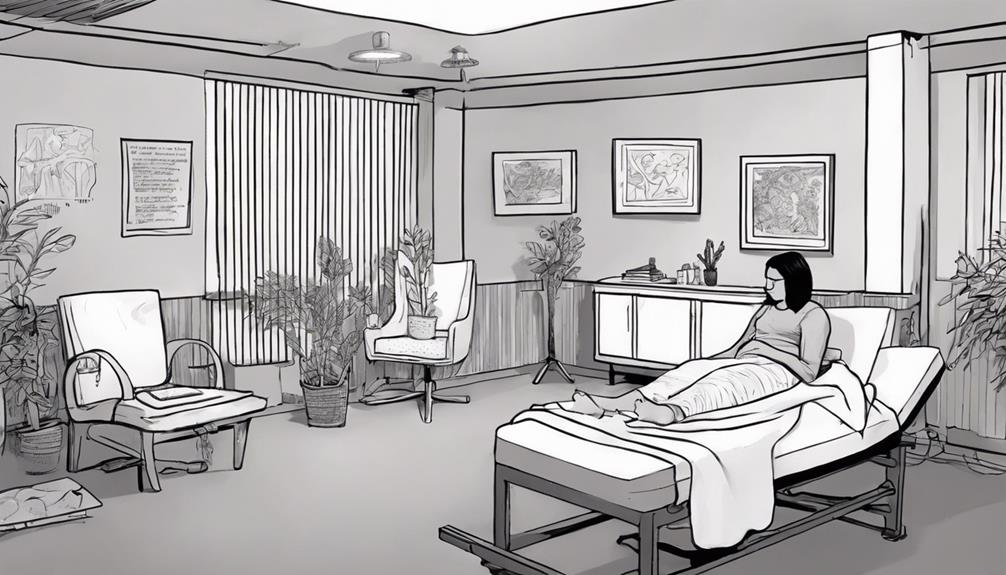Your shoulders can silently hold emotional wounds and forgotten stress stored deep within your body. Muscle tension, knots, and stiffness often reflect unresolved feelings or past trauma that your conscious mind may overlook. These physical cues serve as carriers of emotional history, releasing or shifting as you become more aware of your body’s signals. Paying attention to this connection can help you understand and release what’s been stored there. Keep exploring to uncover more about what your body’s telling you.
Key Takeaways
- Shoulders often store emotional tension from past trauma, acting as physical reminders of forgotten or suppressed feelings.
- Body memory causes muscles to tense or knot in response to unresolved emotional experiences.
- Physical sensations in shoulders can trigger emotional release when recognized and addressed.
- Releasing shoulder tension through awareness and somatic techniques helps access and process stored emotional memories.
- Recognizing shoulder muscle tension as body memory enables holistic healing and emotional well-being.

Have you ever experienced a sudden rush of emotion or a physical sensation that feels rooted in your past? Maybe your shoulders tense up unexpectedly, or you notice a tightness that seems to come from nowhere. That’s your body’s way of holding onto memories you might not consciously remember. Our bodies store more than just physical injuries; they also preserve emotional experiences through muscle tension and other physical cues. When you encounter a situation that echoes past trauma or unresolved feelings, your body responds instinctively, often without your awareness. This is the essence of body memory—where physical sensations become carriers of emotional history.
Muscle tension plays a central role in this process. Over time, your muscles can become stiff or knotted as a response to emotional stress or trauma. For example, if you experienced anxiety or fear during a difficult time, your shoulders might have tensed as a subconscious protective response. Even if you don’t remember the specific event, your body retains that tension. It’s as if your muscles are silent witnesses, holding onto the emotional weight long after the original event has faded from your conscious mind. When you experience emotional release—such as during therapy, mindfulness, or relaxation techniques—those stored tensions start to loosen. This release is often accompanied by feelings of relief and a sense that something long-buried has been acknowledged and processed.
Muscle tension stores emotional pain, releasing it brings relief and healing.
The fascinating part is how this physical memory influences your daily life. You might find yourself unconsciously carrying stress in your shoulders, leading to headaches or discomfort. Sometimes, a simple touch or movement can trigger a wave of emotional release rooted in past experiences. Your body is trying to communicate what your conscious mind has forgotten or suppressed. Recognizing this connection can be empowering because it allows you to address emotional wounds through physical awareness. Techniques like body scans, somatic therapy, or mindful breathing help you tune into these stored tensions, giving your body a chance to release what it’s been holding onto. Additionally, understanding how muscle tension acts as a vessel for emotional memories can guide you toward more holistic healing approaches.
Understanding that your shoulders and muscles remember what your mind might have forgotten can change how you approach emotional health. Instead of solely focusing on thoughts or memories, you can listen to your body as a guide. Releasing muscle tension isn’t just about physical comfort; it’s about clearing emotional baggage stored deep within your tissues. When you pay attention to how your body reacts, you empower yourself to heal long-standing emotional wounds, allowing your body to finally let go of what it has been silently carrying all along.
Frequently Asked Questions
Can Body Memory Be Intentionally Recalled or Accessed?
You can intentionally access body memory through muscle recall and sensory awareness. By focusing on specific areas, like your shoulders, and paying close attention to sensations, you may release stored memories. Techniques such as mindful movement or guided visualization help you tune into subtle signals, making it easier to retrieve forgotten experiences. With practice, you develop a stronger connection to your body’s innate ability to remember, aiding emotional healing and self-awareness.
How Does Body Memory Influence Emotional Responses?
You might notice that your body reacts emotionally through muscle tension and emotional triggers, revealing how body memory influences your feelings. When you face certain situations, your shoulders may tense up or your posture shifts, reflecting stored emotional responses. These physical reactions act as signals, showing how past experiences are embedded in your muscles. Recognizing this connection helps you understand and manage your emotional responses more effectively.
Is Body Memory Linked to Past Trauma or Injury?
It’s no coincidence that your body might hold onto trauma or injury in your shoulders. Body memory often links to past trauma, which can manifest physically through tension or pain. Somatic healing helps you access and release this stored trauma, enabling trauma release and easing emotional burdens. Recognizing this connection allows you to work through unresolved issues, transforming your physical and emotional well-being.
Can Body Memory Be Trained or Reprogrammed?
Yes, you can train or reprogram your body memory through muscle reconditioning and somatic exercises. These methods help you consciously reconnect with stored sensations, releasing tension and reshaping habitual patterns. By regularly practicing mindful movements, you retrain your nervous system and muscles, allowing old memories to fade and new, healthier responses to take their place. This process empowers you to regain control over your body’s responses and improve overall well-being.
How Does Body Memory Differ From Conscious Memory?
You might wonder how body memory differs from conscious memory. Body memory involves muscle tension and sensory recall, where your body stores past experiences physically. Unlike conscious memory, which you actively remember, body memory happens automatically, often triggered by specific sensations or movements. Your shoulders, for example, can hold tension from emotional events without you consciously realizing it, revealing how deeply body memory is embedded in your physical responses.
Conclusion
Your shoulders hold onto memories like quiet sentinels, silently bearing the weight of forgotten moments. Every tense muscle and subtle shift tells a story your mind might have erased, but your body remembers. Imagine these hidden stories as faint echoes trapped beneath your skin, waiting to be uncovered. By listening to your body’s whispers, you can begin to unravel what your shoulders have quietly held onto—bringing forgotten memories back into the light where they belong.










